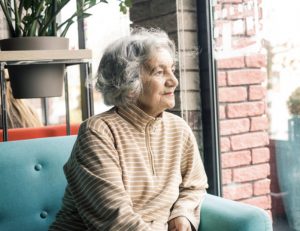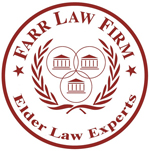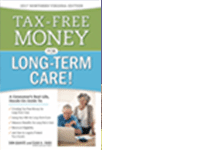 On a recent afternoon, Ruth Deardorff, 97, sat by the orchids and other potted flowers that she had chosen to line the windowsill of her room. After decades of gardening and growing flowers in the yard of her suburban home, she finds comfort in having flowers in her room. Ruth feels safe and content in the room where she resides, especially since there have been no COVID cases in her facility.
On a recent afternoon, Ruth Deardorff, 97, sat by the orchids and other potted flowers that she had chosen to line the windowsill of her room. After decades of gardening and growing flowers in the yard of her suburban home, she finds comfort in having flowers in her room. Ruth feels safe and content in the room where she resides, especially since there have been no COVID cases in her facility.
That’s right— not a single resident has contracted the coronavirus at the non-traditional small residential facility where Deardorff resides. At this particular facility, the physical environment resembles a family home (usually 8–12 people) and residents keep their own sleeping and meal schedules. All residents are cared for by certified nursing assistants (CNAs) referred to as shahbazim, who work in self-managed teams and are responsible for direct resident care, cleaning, laundry, meal preparation, staff scheduling, and activities, and simulating how families might organize work. These CNAs earn up to 30% more than their counterparts, which is usually enough not to take a second job. The model that I describe is known as the “Green House” model, part of a movement that has been around for 20 years.
Green House Residents A Lot Less Likely to Get Coronavirus
When NPR’s Ina Jaffe describes Green Houses, she emphasizes how they feel like home. Green Houses practice what’s called “consistent assignment,” meaning that the same CNAs care for the same few residents. With less residents and less aides, during the pandemic, Green House homes have been one-fifth as likely to have cases of COVID-19 as other senior living facilities.
The Green House Project was founded by Bill Thomas, M.D., a Harvard-educated physician. He earlier founded the Eden Alternative, an approach emphasizing older adult care that’s focused on people rather than institutions. The first Green House home opened in Tupelo, Mississippi, in 2003 when Thomas persuaded a top administrator to choose this model rather than replace an older-style senior home.
Green House Senior Living Isn’t Widespread, But Others Can Learn from Them
The Green House Project may have been around for nearly two decades, but it is not very widespread. As of this year, the 2,500 Green House residents in the United States. Although it works well in many ways, there are reasons for this that I will describe.
The majority of Green House facilities tend to be located in upscale neighborhoods. The costs of living in them are incredibly high (significantly higher than any assisted living facilities in our area) and are therefore unaffordable for most of us. While the Greenhouse model may not currently be accessible to most, there are themes and innovations within the model that are worth exploring and scaling, and that can be implemented within the context of existing facilities to reach more residents. The Green House Model can serve as a positive model as other long-term care facilities work to address the structural challenges that left residents vulnerable as COVID-19 took hold.
Strengthening Long-Term Care: Recommendations from a Green House Model Advocate and Harvard Professor
The Green House model has been praised by academics and doctors for its person-based philosophy and its ability to stave off the spread of infection and the isolation that has devastated seniors in recent months. Dr. David Grabowski, professor of health care policy at Harvard Medical School, is an advocate for the Green House Model. He explains what policies could be put into place to help all senior living facilities at this time.
Dr. Grabowski was one of 25 people on the Coronavirus Commission for Safety and Quality in Nursing Homes, and the research he uncovered during this pandemic is certainly intriguing. Dr. Grabowski believes that even if the Green House model is not widespread or accessible to many seniors, a number of changes based on the model could strengthen all senior living facilities, especially during the COVID-19 pandemic. The measures below are a sampling of his recommendations related to regulation, staffing, quality reporting, and delivery of care:
According to Dr. Grabowski, (t)hese policy measures are going to take resources. He said, “(t)he consequences of our historical underinvestment in nursing homes have been laid bare by the COVID-19 pandemic, which has taken a deadly toll on residents and staff. It is time to reform nursing home policy to protect the residents of these facilities and the individuals who care for them.”
Is Assisted Living the Right Option?
Assisted living can be a viable option when a person can no longer live alone, such facilities come with a steep price. In last year’s Cost of Care Survey conducted by Genworth Financial, $5,000 to $8,000 per month is common for assisted living in our area, depending on the level of care needed. And keep in mind that Medicaid is not going to cover the cost of any of this, unless possibly you live in DC.
Some people have the means to pay for assisted living with their own income and retirement nest eggs. However, savings easily can become depleted by a $60,000 – $90,000 annual bill for assisted living. You could also consider paying for assisted living with a life insurance policy or a hybrid LTC insurance policy, as described in my article from earlier this year, “How to Afford Assisted Living.”
Plan for Loved Ones Who Need Nursing Home Care Now or in the Future
Many of us have loved ones who need nursing home care because they require higher levels of care than generally can be provided at home or in assisted living. If you have a loved one who needs nursing home care or even if your loved one is already in a nursing home, and if you haven’t done so already, the time to plan is now! Please contact us as soon as possible to make an appointment for an initial consultation:
Elder Care Fairfax: 703-691-1888
Elder Care Fredericksburg: 540-479-1435
Estate Care Rockville: 301-519-8041
Elder Care DC: 202-587-2797












